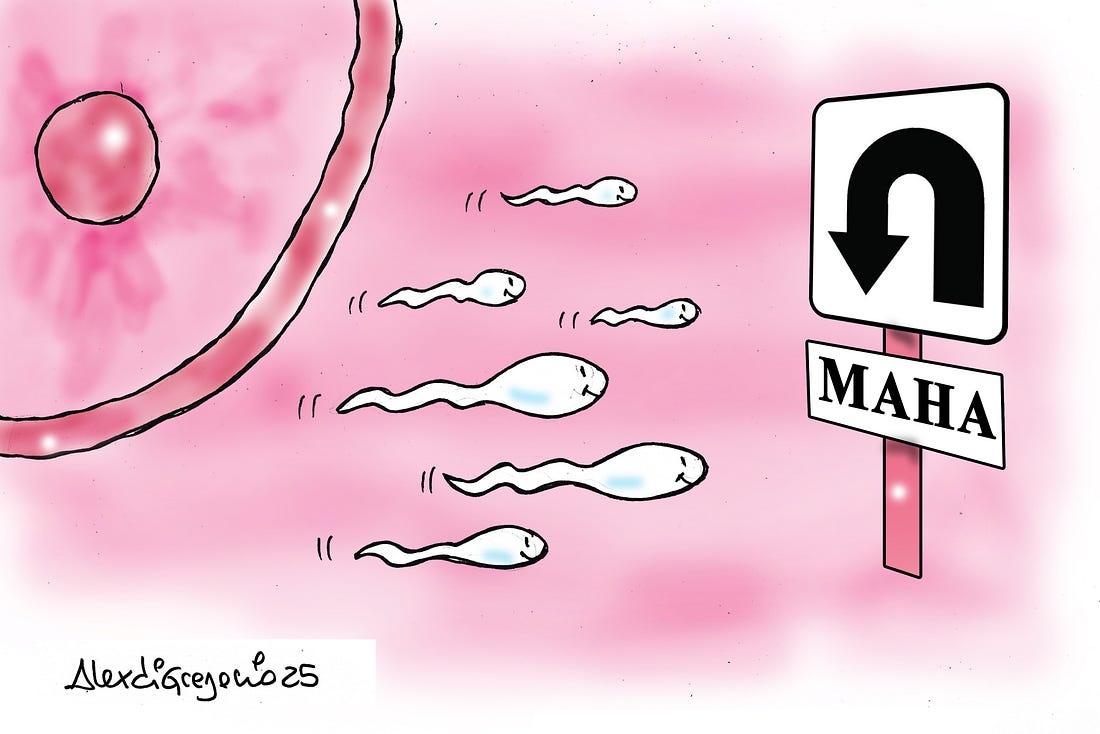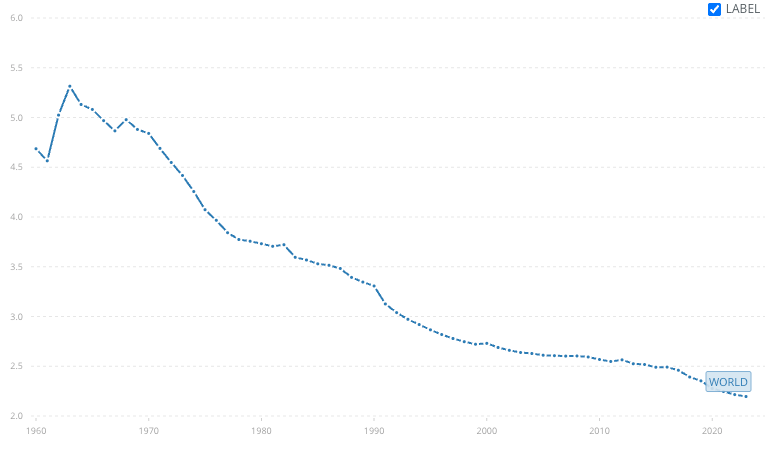Crashing Sperm Counts! Dwindling Fertility Rates! What’s Causing the Male Sperm Count Crisis and Why It Must Be Stopped
October 23 | Posted by mrossol | Big Food, Food, HealthAnother very serious health challenge that has been essentially ignored, and would still be ignored except the DJT nominated RFK, Jr. to H.H.S. And I would kindly as possible say: We can’t have MAHA with our MAGA. mrossol
By James Lyons-Weiler, Science and Medicine Contributor, The MAHA Report
At a White House press conference in the Oval Office on October 18, convened to announce a landmark plan to make in-vitro fertilization more accessible and affordable, U.S. Health & Human Services Secretary Robert F. Kennedy Jr. startled attendees when he declared that America’s fertility rate had plunged from roughly 3.5 births per woman in the early 1960s to about 1.6 today — well below the 2.1 threshold needed to maintain the population.
Photo by Alessandro Di Gregorio
In front of news cameras, Kennedy also warned that the slide into sub-replacement fertility (which results in shrinking the population) is “a national security threat.” Critics mocked the Secretary’s choice of words, with headlines calling what he said a “rant.”
Yet the numbers behind Kennedy’s statement tell a story that is neither fringe nor speculative—it’s measurable, alarming, and documented in the scientific record.
“When my uncle was president,” Kennedy said, “the fertility rate in this country was 3.5. Today it’s 1.6. Replacement is 2.1. We are below replacement.”
He’s right.
In the early 1960s, the United States averaged 3.6 births per woman. Today, it hovers near 1.6, a record low. The Centers for Disease Control and Prevention (CDC) confirmed a total fertility rate (TFR) of 1.621 in 2023 and 1.627 in 2024—barely three-quarters of the level required to sustain the population without immigration.
That decline has persisted for more than a decade, even as the economy expanded and maternal health improved. The trend has no precedent in modern U.S. history.
Dwindling Sperm
Kennedy’s deeper claim—that young men today have roughly half the sperm counts and testosterone levels their grandfathers had when they were young—sounded hyperbolic to some listeners. But, again, the scientific literature backs up the downward trend.
A 2023 Human Reproduction Update meta-analysis spanning 223 studies (1973–2018) found a 52% decline in mean sperm concentration and a 62%decline in total sperm count among men worldwide. The steepest drops occurred after 2000. Researchers interpret the results as a generational phenomenon—each new birth cohort beginning adulthood with lower reproductive potential than the last.
Meanwhile, a 2021 European Urology Focus study, using U.S.National Health and Nutrition Examination Survey(NHANES) data, confirmed a significant downward trend in testosterone among males ages 15–39, even after adjusting for weight and lifestyle factors. Earlier longitudinal work from the Journal of Clinical Endocrinology & Metabolism (2007) found similar multi-decade declines in adult men. Together, the results describe a biological pattern consistent with Kennedy’s generational narrative: the average teenage boy now begins with lower androgenic and reproductive baselines than his father did.
Girls Are Changing, Too
Parallel changes appear in girls and young women. In a 2024 JAMA Network Open cohort of 71,341 participants, the average age at menarche (the beginning of menstruation) fell from 12.5 years (for women born in 1950–1969) to 11.9 years (for those born in 2000–2005). The share of early puberty—before age 11—rose from 8.6% to 15.5%. CDC’s 2020 National Health Statistics Report confirmed the downward trend.
That means girls are entering reproductive maturity earlier, while boys are trending toward reduced fertility and lower hormonal strength—a biologically discordant shift across generations.
A Matter of National Security
Kennedy framed the crisis in geopolitical terms. “Below replacement is a national security threat,” he said—and demographers quietly agree the wording is not misplaced. With the birth rate far below replacement, the U.S. population continues to grow only through immigration—up roughly 1% in 2024, the fastest pace since 2001. But such growth is not self-sustaining.
Fewer births mean an aging labor force and shrinking military recruitment pools. The Congressional Budget Office projects that by 2040, one in five Americans will be over 65. Economists warn that innovation and tax base resilience could falter if fertility remains stalled.
As demographer Lyman Stone recently observed, “Low fertility isn’t just a lifestyle statistic. It’s the early symptom of national fatigue.”
What’s Driving the Decline?
A wide mix of everyday chemicals—found in plastics, packaging, cosmetics, and even household dust—has been linked to lower fertility and hormone disruption in both men and women. Researchers point to an even more complex mix: delayed marriage, economic uncertainty, environmental toxins, endocrine disruption, chronic stress, and declining sperm quality. Persistent organic pollutants, phthalates, PFAS, and hormonal contraceptive residues have all been implicated in reproductive impairment. Scientists don’t yet agree on how much each factor contributes, but they do agree the shift isn’t simply cultural.
Something biological and environmental has changed in how modern life affects the human body. Though causation is still debated, the convergence of demographic and biological data suggests a systemic drift—not a social fad.
Endocrinologist Dr. Sanjay Lokeshwar calls it “a slow, silent epidemic.” He has said, “We’ve tracked cardiovascular health for decades. But reproductive health—our most fundamental biological capital—has collapsed without a plan.”
Part of the story is timing. Americans are waiting longer to start families. The average woman now has her first child near age twenty-eight—three years later than a generation ago—and that delay leaves less time for additional children. Fewer marriages, heavier student debt, and the high cost of housing all feed the pattern.
Health trends matter, too. Rising rates of obesity, diabetes, and thyroid problems interfere with hormones that control reproduction. Men are showing measurable declines in sperm quality; women face higher rates of ovulatory disorders and pregnancy complications.
The environment adds its own pressures. Researchers have found that people exposed to higher levels of industrial and household chemicals often show subtle changes in hormone balance. While most exposures are low, they are nearly constant—from food containers to tap water—and may act together over time.
Stress may be the most underestimated factor of all. Studies from Japan, South Korea, and the U.S. link economic insecurity and long working hours to falling birth rates even among couples who say they want children. “You can’t separate fertility from hope,” says demographer Lyman Stone. “People have fewer children when they can’t picture a stable future.”
The question now is whether the decline can be reversed—or whether it marks a permanent shift in the biology and economics of modern life.
The Way Forward
What Kennedy’s detractors dismissed as political theater may ultimately be foresight. Fertility decline is no longer confined to affluent nations—it’s global, and accelerating. The science doesn’t support panic, but it does demand acknowledgment.
Whether the response comes through environmental reform, reproductive health investment, or renewed family policy, one fact is no longer in dispute: America’s next generation will be smaller, hormonally weaker, and slower to replace itself.
Solving this crisis will take more than urging people to have babies. Governments can create conditions that make family life possible: affordable housing, paid parental leave, and health coverage that treats infertility as a medical condition, not a luxury. Environmental agencies can phase out chemicals tied to hormonal interference, and employers can re-design work around family formation rather than against it.
And that, as Kennedy warned, is not merely a demographic curiosity. It’s a national security problem – but one that can and must be solved.
Thank you for subscribing to The MAHA Report








Leave a Reply
You must be logged in to post a comment.